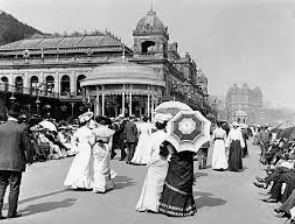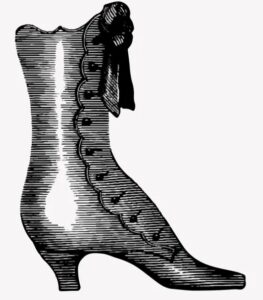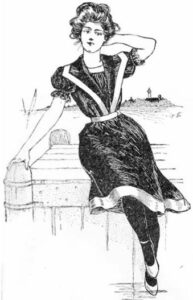Our current health campaign is ‘Summer Safety’, providing advice to ensure safety and fun in the sunshine, on holiday and at festivals.
 If you are lucky enough to be getting ready for an upcoming summer holiday, you might be in the middle of deciding what clothes to pack. This can be a bit of a nightmare in my experience. It’s one of those tasks that I put off until the last minute, particularly if it’s a staycation in the UK. Do I take shorts for a heatwave or long trousers for snow?
If you are lucky enough to be getting ready for an upcoming summer holiday, you might be in the middle of deciding what clothes to pack. This can be a bit of a nightmare in my experience. It’s one of those tasks that I put off until the last minute, particularly if it’s a staycation in the UK. Do I take shorts for a heatwave or long trousers for snow?
Wherever our holidays take us, be it St Tropez or St Albans, we might think ourselves lucky that we aren’t Victorian women of a certain class, getting ready to go on holiday in the summer of 1896. According to the Woman’s Signal periodical held in our archive collection, if you were heading off to Eastbourne that summer, you would have needed a very large suitcase because it was fashionable to change clothes up to 4 times a day!
If you had chosen this particular destination, the author of ‘What to Wear – Dress for the Seaside’, tells us that a number of dresses would be required because it was ‘fashionable to make a fresh toilette three or four times a day.’ Each seaside place had its own fashions, so that ‘the dress that looks well in one locality is totally inappropriate in another’, with a blunt reminder along the way that we shouldn’t dress ‘carelessly’, even at holiday time.
A full rundown of must have clothing is provided for a day at the seaside in Eastbourne. Starting off in a dainty dress, you would spend your morning on the prom. The promenade was an essential element of the Victorian seaside holiday. It was viewed as a chance to take in the fresh air and exercise but it was also an excuse to be seen by society, decked out in your finest outfit. For the sunny weather ‘pink looks particularly well on the parade in the morning, and one sees linen and cambric dresses in white, holland-colour, pale blue, scarlet, mauve, and every colour of the rainbow.’ Dainty dresses were replaced by heavier dresses on a dull or chilly day, tailor made in simple tweed was recommended or a navy serge yachting suit.
Following your morning promenade, it was time to change for the afternoon, which was ‘usually spent in watching the tennis players in the Devonshire Park’. Eastbourne’s oldest park included racquets and skating for the Victorian middle classes. You were advised to wear ‘as smart a dress as one would choose for the Eaton and Harrow day at Lord’s.’ However, you wouldn’t need to go to the expense of buying new afternoon dresses, as you could ‘finish out the visiting-gowns which had served their purpose in London during the season.’
On to dinner and another change was required, this time into a comfortable tea-gown. If you were going out to a concert after dinner in the evening, I’m afraid you would need to change for a fourth time! This sounds like the most extravagant attire for the day, where people wore ‘much the same kind of dress which would be worn in a foreign casino’. Smart hats were worn, trimmed with an abundance of flowers, elbow length sleeves and long white gloves. If you were chilly on the way home, then a wrap or feather boa would help to keep you warm.
 Apart from the very large wardrobe of clothes that you would need on this holiday, you would probably be pretty worn out from the time spent ‘in that tedious process of “buttoning and unbuttoning”’. Worryingly, we are told that this laborious process could literally drive you over the edge. Just imagine no zips, just buttons, hooks and laces and getting in and out of all that clothing four times in one day. Was this a relaxing holiday!?
Apart from the very large wardrobe of clothes that you would need on this holiday, you would probably be pretty worn out from the time spent ‘in that tedious process of “buttoning and unbuttoning”’. Worryingly, we are told that this laborious process could literally drive you over the edge. Just imagine no zips, just buttons, hooks and laces and getting in and out of all that clothing four times in one day. Was this a relaxing holiday!?
However, if you wanted to be ‘free from the troubles of the toilette’, you could always choose to go farther afield to a quieter place, where ‘everyone goes about in their worst hats and oldest clothes and a smart toilette would be viewed with disfavour and suspicion.’ Helpfully, all you would need here apparently was ‘a sailor hat, a print blouse, a serge skirt and no gloves’ for the day and for the evening just a pretty blouse or a tea dress would be worn. There were evidently places to visit where you didn’t need to follow such a strict toilette as a visit to Eastbourne would require, but the writer reminds us that we shouldn’t look ‘absolutely shabby’. After all, you were likely to meet your friends if you were spending every morning on the promenade.
 Factor in the Victorian desire to hide almost the entire body whilst swimming and you would need a hefty set of clothes on your travels. Women typically dressed in knee-length, wool dresses, often featuring a sailor collar, and worn over bloomers. This bathing costume also came with long black stockings, lace-up bathing slippers and a fancy cap.
Factor in the Victorian desire to hide almost the entire body whilst swimming and you would need a hefty set of clothes on your travels. Women typically dressed in knee-length, wool dresses, often featuring a sailor collar, and worn over bloomers. This bathing costume also came with long black stockings, lace-up bathing slippers and a fancy cap.
Maybe I won’t complain about packing for my next holiday….
We welcome enquiries regarding our archive collection. To make an enquiry or to find more out about visiting our archive, please email us at archives@white-ribbon.org.uk or phone 0121 744 3214.
Source:
The Woman’s Signal 27 August 1896 – White Ribbon Association Archive
